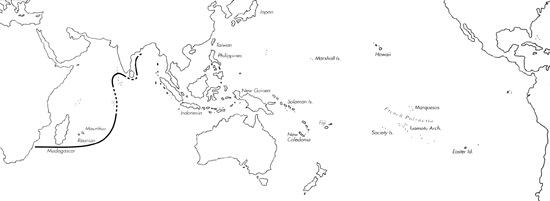Range: Mozambique to Red Sea and to S. India; absent from Maldives.
Description: Medium-sized to large, solid to moderately heavy. Last whorl conical to narrowly conical, outline variably convex adapically and straight below. Shoulder angulate. Spire of low to moderate height, outline deeply concave to almost straight, with a conoid apex of about 7-8 postnuclear whorls projecting from an otherwise nearly flat spire. Maximum diameter of larval shell about 0.75 mm. First 7 postnuclear whorls weakly tuberculate. Teleoconch sutural ramps flat to concave, with obsolete spiral striae in late whorls. Last whorl with fine spiral ribs at base, obsolete in larger specimens.
| Shell Morphometry | ||
|---|---|---|
| L | 50-83 mm | |
| RW | 0.30-1.06 g/mm | |
| (L 50-80 mm) | ||
| RD | 0.48-0.62 | |
| PMD | 0.85-0.92 | |
| RSH | 0.03-0.18 | |
Ground colour white. Last whorl with 2 broad light to dark brown spiral bands, either solid or split into axial streaks, flames, blotches or bands, leaving ground-colour zones at shoulder, at or below centre and near base. White subshoulder band narrow, usually crossed by axial extensions of adapical colour band. White central band variable in width, almost immaculate to heavily maculated with extensions of colour bands, occasionally completely absent. White abapical zone broad or narrow, sparsely to heavily maculated with brown. Minutely dotted to largely solid brown spiral lines extend from base to shoulder but vary widely in number and arrangement; occasionally, spiral lines partly interrupted by white dots and sparse, small white tents. Base dark brown to violet-brown. Larval whorls pink. Early postnuclear sutural ramps immaculate; late ramps with curved brown radial markings. Aperture white.
Periostracum yellowish olive, thin to moderately thick, translucent to opaque, and smooth or with fine axial ridges.
Dorsum of foot pale yellow mottled with dark grey. Sole of foot pale orange, mottled with black, with less black posteriorly; anterior end red, followed by a black transverse band. Rostrum black with white spots. Tentacles grey with white spots. Siphon yellow, with a dark grey mottling distally or siphon black, grading to grey at anterior end, with white spots (Fainzilber et al., 1992; Kohn, unpubl. observ.).
Radular teeth with an adapical barb opposite a medium-sized blade; serration about twice as long as blade; no basal spur (Peile, 1939).
Habitat and Habits: Slightly subtidal to about 6 m on reefs and coastal flats, in sand, sandy gravel or rubble, sometimes beneath coral blocks among weed (Grosch, pers. comm, 1989; Stabenow, pers. comm., 1989; Lorenz, pers. comm., 1990).
Discussion: C. maldivus is very similar to C. generalis and cannot always be unequivocally separated from this species by conchological characters. The only reliable difference is in the colour pattern: In C. generalis, the basic pattern consists of 2 spiral colour bands that are usually solid and rarely split into axial fragments, and that cross underlying darker axial streaks or flames extending over the entire last whorl; the adapical ground-colour band is usually broader and the dark spiral lines rarely consist of minute dots or become solid. C. maldivus occurs with C. generalis form krabiensis at Mandapam, S. India, without producing conchological intermediates (Röckel, 1989). We therefore consider them as separate species. For comparison between C. maldivus and C. monile, see the Discussion of the latter species. The shell of C. bayani has carinate shoulder; the last whorl is white at the anterior end and has spiral colour bands overlying axial pattern elements. The shells of C. capreolus are lighter than those of C. maldivus, the bases are white, late postnuclear whorls are carinate and lack radial markings, and darker spiral lines are absent from their last whorl. C. planaxis and C. spirogloxus (Pl. 33, Fig. 20) refer to juvenile specimens assigned to C. maldivus mainly on account of their type localities.

C. maldivus range map
This section contains verbatim reproductions of the accounts of 316 species of Conus from the Indo-Pacific region, from Manual of the Living Conidae, by Röckel, Korn and Kohn (1995). They are reproduced with the kind permission of the present publisher, Conchbooks.
All plates and figures referred to in the text are also in Röckel, Korn & Kohn, 1995. Manual of the Living Conidae Vol. 1: Indo-Pacific Region.
The range maps have been modified so that each species account has it own map, rather than one map that showed the ranges of several species in the original work. This was necessary because each species account is on a separate page on the website and not confined to the order of accounts in the book.